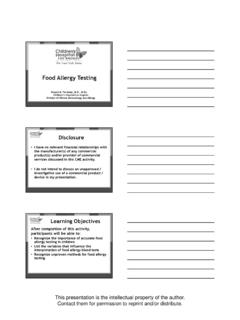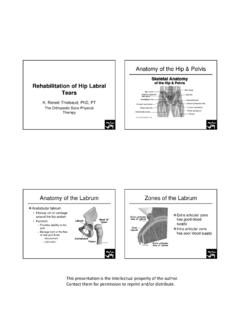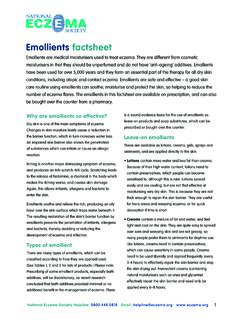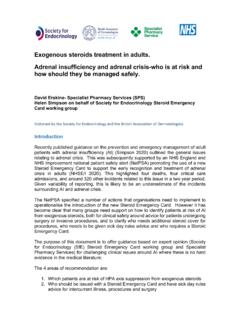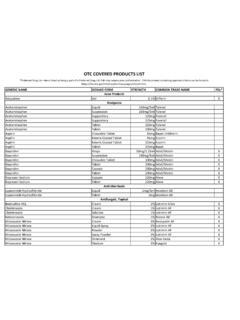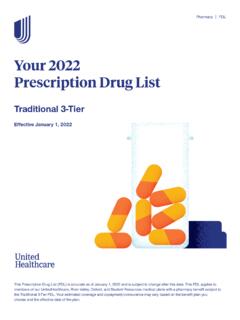Transcription of CTCAE Grading Scale in Managing Immune- Mediated …
1 This presentation is the intellectual property of the author. Contact them for permission to reprint and/or Crabbe, MSN, APRN-BC, AOCNCTCAE Grading Scale in Managing Immune- Mediated Adverse EventsThis image cannot currently be display Credit: Disclosure I have nothing to image cannot currently be display Credit: Terminology Criteria for Adverse Events Grade: Refer to the severity of the adverse event (AE). Grade 1: Mild, asymptomatic Management: Observation, intervention not needed. Grade 2: Moderate Management: Local or noninvasive intervention indicated Will likely need low dose oral steroids and may be able to continue treatment Grade 3: Several or medically significant but not immediately life-threatening Management: Stop immunotherapy, hospitalization indicated, high dose steroids Grade 4: Life-threatening consequences Management: Urgent intervention, will permanently stop immunotherapy Grade 5: Death related to AENCI CTCAE image cannot currently be display Credit.
2 AgentsCTLA-4PD-1 PDL-1 image cannot currently be presentation is the intellectual property of the author. Contact them for permission to reprint and/or image cannot currently be display Credit: Cell Response: Accelerate or Break T cell inhibitory signals: CTLA-4, PD-1 & LAG-3 inhibitory signals brake the immune system and can dampen or inhibit T-cell responses. In general, without these inhibitory mechanisms, rampant autoimmune disease would emerge. Checkpoint inhibitors such as those against CTLA-4 and PD-1, however, are an advantageous example of circumventing these inhibitory signaling mechanisms.
3 This image cannot currently be display Credit: 067: Treatment-Related AE s Associated with Nivo and Ipi Select Grade Treatment AE s, %Nivo + IpiNivoIpi(n = 313)(n = 313)(n = 311) Any select AE40819 Skin623 Pruritus20<1 Rash3<12 Maculopapular rash2<1<1 Gastrointestinal15212 Diarrhea926 Colitis8<19 Hepatic (AST, ALT)1932 Endocrine 5<12 Pulmonary (pneumonitis)1<1<1 Larkin J et al. (2015). N Engl J Med, 373, image cannot currently be display Credit: AE s with Immunotherapy Skin: Dermatitis exfoliative, Erythema multiforme, Steven s-Johnson syndrome, Toxic epidermal necrolysis, Vitiligo, Alopecia Eyes: Uveitis, Iritis Endocrine: Hypothyroidism, Hyperthyroidism, Adrenal insuffiency, Hypophysitis Pulmonary: Pneumonitis, Interstitial lung disease, Acute interstitial pneumonnitis Gastrointestinal: Colitis, Enterocolitis, Necrotizing colitis, GI perforation Hepatic: Hepatitis autoimmune Renal: Nephritis autoimmune, Renal failure Neurologic.
4 Autoimmune neuropathy, Demyelinating polyneuropathy, Guillain-Barre, Myasthenia gravis-like symptomsThis image cannot currently be display Credit: Colitis: Symptom Surveillance Monitor for signs and symptoms Median time to onset from first dose about 10 weeks Ask patients to report any bowel habit changes promptly Rule out other cause of diarrhea Clinical Pearl: Colitis can occur without diarrhea. Important to take all GI-related symptoms seriously and evaluate. Nivoumab package insert 2014 This presentation is the intellectual property of the author. Contact them for permission to reprint and/or image cannot currently be display Credit: Colitis: Symptom ManagementMild grade 1: < or = 4 stools/day or above baselineModerate grade 2: Increase of 4-6 stools/day above baseline (persistent)Severe grade 3.
5 > 7 stools/day above baseline Manage symptomatically (bland diet, PPI, antidiarrheal) Consider delaying treatment until symptoms improve Colonoscopy and steroids Low dose steroids may be sufficient Hold treatment Initiate high dose steroids Discontinue treatmentGradeManagementThis image cannot currently be display Credit: Hepatitis: Symptom Surveillance Monitor LFT s at baseline and prior to each dose of treatment Pts with abnormal LFT s should be monitored more frequently Hepatotoxicity appears worse when ipilumumab is combined with other drugsThis image cannot currently be display Credit: Heptatis.
6 Symptom Management Rule out other causes of LFT abnormalities Increase LFT monitoring Corticosteroid treatment with grade 2 or higher LFT s Prolonged taper may be required Mycophenolate may be useful (immunosuppressant) LFT abnormalities appear to be dose dependentLFTG rade 1 Grade 2 Grade 3 Grade 4 Bilirubin> ULN to > to > to > x ULNALT/AST>ULN to > to > to > ULNA lbumin<LLN to 3 g< 3 to 2 g/dL < 2 g/dL--This image cannot currently be display Credit: Dermatitis Reported in up to 40% of pts with anti-CTLA-4 and anti-PD-1 agents Occasionally severe rashes Onset within a few weeks of starting or several weeks/months into therapy Severity driven by symptoms Rule out other etiologies Generally not infusion relatedImage courtesy of Matthew M.
7 Burke, MBA, RN, MSN, APRN-BC and image cannot currently be display presentation is the intellectual property of the author. Contact them for permission to reprint and/or image cannot currently be display Credit: Dermatitis: Symptom ManagementMild/moderate (rash/pruritus)Grade 1 Persistent (> 1 week) or interferes with ADL s Grade 2 Severe Grade 3 or > Topical nonsteroidal cream, antihistamine, oatmeal baths Skin care: Moisturize, sunscreen, avoid sun Moderate-potency steroids creams or Moderate-dose oral steroids D/C treatment High-dose steroids Avoid rapid steroid taperSeverityManagementThis image cannot currently be display Credit.
8 Endocrinopathies Can be serious or fatal if not managed correctly Hypophysitis, thyroid disease and primary adrenal insufficiency have all been reported as well as insulin-dependent diabetes Check TSH, free T3 & T4 at baseline and prior to each dose Monitor glucose Time to onset may be much later; median 11 weeks Endocrinopathies may be permanent Grade 1: Asymptomatic or mild symptoms, observation, no intervention Grade 2: Moderate symptoms, may need thyroid replacement Grade 3: Severe or medically significant, may need hospitalization, insulin or hormone replacement Grade 4: Life-threatening consequences, urgent interventionThis image cannot currently be display Credit: Endocrinopathies.
9 Symptom Management Hormone replacement, corticosteroids Possibly delay treatment (usually not for thyroid) Co-syntropin stimulation test prior to starting steroidsor send to endocrinologist Many endocrinopathies can be controlled if hormone levels are stable with < mg of prednisone, treatment can be continued. Pre-existing thyroid disorder does not predispose pts for developing additional endocrinopathies as far as we know. Grade 3 & 4 AE s discontinue therapyThis image cannot currently be display Credit: Pneumonitis Fairly uncommon, but potentially serious (3% of pts) Deaths have been reported Need to carefully monitor pts Pts at increased risk for pneumonitis NSCLC in the setting of chronic lung inflammation Heavily pretreated pts Combination of CTLA-4 and PD-1 agents Prior radiation to lung History of COPD Grade 1: Asymptomatic, may show up on xray or CT scan, intervention not indicated Grade 2: Symptomatic, medical intervention indicated Grade 3: Severe symptoms.
10 Limiting self care ADL, oxygen neededThis presentation is the intellectual property of the author. Contact them for permission to reprint and/or image cannot currently be display Credit: Pneumonitis: Signs and Symptoms Shortness of breath, Dry cough New or increasing oxygen needs, or Decreasing O2 sat on room air May be detected just on imagingThis image cannot currently be display image cannot currently be display image cannot currently be display : Prepneumonitis1/21/14: Pneumonitis2/21/14: Improved with steroids; taper completed 3/7/14 This image cannot currently be display Credit: Pneumonitis: Symptom Management Grade 1: Close observation and is seen on outside films, get those films and compare to previous and obtain chest xray of CT chest Grade 2: Low dose steroids, may delay treatment Grade 3: May need hospitalization and high dose parenteral steroids, discontinue treatmentThis image cannot currently be display Credit: Immune- Related AE s Immune- related AE s include Ocular manifestations: conjunctivitis, uveitis, and scleritis Neurologic complications.

